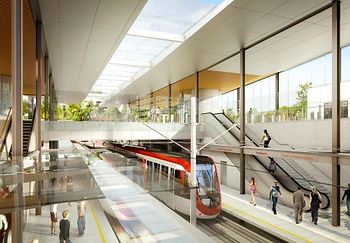Transportation Facilities and Active Transportation
Accessibility Simplified has worked with project teams on addressing accessibility of a range of transportation modes throughout the entire transportation chain: - the way people get from point A to point B - from home to destination.
Accessibility Simplified recognizes how integral it is to ensure that everyone in our communities, including people with disabilities and older persons, can safely and independently go where ever they want, be it to work, shopping or to a friend’s house.
Accessibility Simplified has experience addressing accessibility of the built and landscape environments of transportation facilities through Architectural Drawing Reviews and Facility Accessibility Audits, and how these facilities tie in with active transportation, Public Rights of Way and accessible streetscape.
Accessibility Simplified has worked with industry leading firms in relation to Active Transportation, and how it interfaces with other modes, including transit, general traffic and particularly pedestrian movement. Walking and cycling interactions can present safety risks to pedestrians and to AT users. Addressing accessibility and universal design at the early design stages can mitigate those risks for everyone.

Case Study: Active Transportation
Marnie Peters & Co Inc. (now Accessibility Simplified) is working with WSP and Alta Planning + Design on the redevelopment and update to the Ontario Traffic Manual - Book 18: Cycling Infrastructure manual to ensure that accessibility and universal design are fully considered and addressed for all cycling infrastructure guidelines being presented through the Manual.
Compliance with the AODA - Design of Public Spaces is also being addressed not only for urban infrastructure, but also for trails and other rural infrastructure.

Case Study - Transportation Facility | PROW
Marnie Peters & Co Inc. (now Accessibility Simplified) were part of a larger project team that completed architectural plan reviews of all of the below ground and above ground stations for the City of Ottawa’s Confederation Line (Phase 1) to ensure that the $2.1 billion transit project will be compliant with a range of minimum accessibility requirements and demonstrate the implementation of best practices wherever possible.
In addition to architectural drawing reviews, reviews of drawing for associated elements including signage and wayfinding were completed with compliance issues identified and recommendations provided.

Case Study: Transportation Facility
Marnie Peters & Co Inc. (now Accessibility Simplified) worked collaboratively as part of a multi-faceted design team in the development of a new terminal building and detached parking structure. Work included the review of construction drawings at 30-60-90%, conducting a post occupancy accessibility audit and developing detailed and comprehensive recommendations to ensure the facility was not only in compliance with accessibility requirements, but that it also incorporated unique accessible design features and best practices in universal design in order to create an accessible environment that is functional for the greatest number of users.








